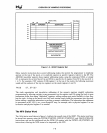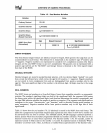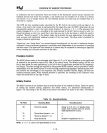
1'1
L'
-1.67x10
308
OVERVIEW OF NUMERIC PROCESSING
NEGATIVE RANGE
(NORMALIZED)
• I
-5 -4
-3 -2
-1
:
.J'" I'" 1''''1''''1'''''1' ]
-4.19x10-
a07
I ,
POSITIVE RANGE
(NORMALIZED)
Figure 1-8.
80287
Number System
iii I
G30108
From a practical standpoint, the 80287's set of real numbers
is
sufficiently large and dense
so
as not
to limit the vast majority of microprocessor applications. Compared to most computers, including
mainframes, the
NPX provides a very
good
approximation of the real number system.
It
is
important
to
remember, however, that
it
is
not an exact representation, and that arithmetic
on
real numbers
is
inherently approximate.
Conversely, and equally important, the 80287
does
perform exact arithmetic
on
integer operands. That
is, an operation
on
two
integers returns an exact integral result, provided that the true result
is
an
integer and
is
in range. For example, 4 + 2 yields an exact integer. I + 3
does
not, and 2
40
X 2
30
+ 1
does not, because the result requires greater than 64 bits of precision.
Data Types and Formats
The 80287 recognizes seven numeric data types, divided into three classes: binary integers, packed
decimal integers, and binary reals. A later section describes
how
these formats are stored
in
memory
(the sign
is
always located in the highest-addressed byte). Figure
1-9
summarizes the format of each
data type. In the figure, the most significant digits of all numbers (and fields within numbers) are the
leftmost digits. Table
1-5
provides the range and number of signficant (decimal) digits that each format
can accommodate.
1-15


















